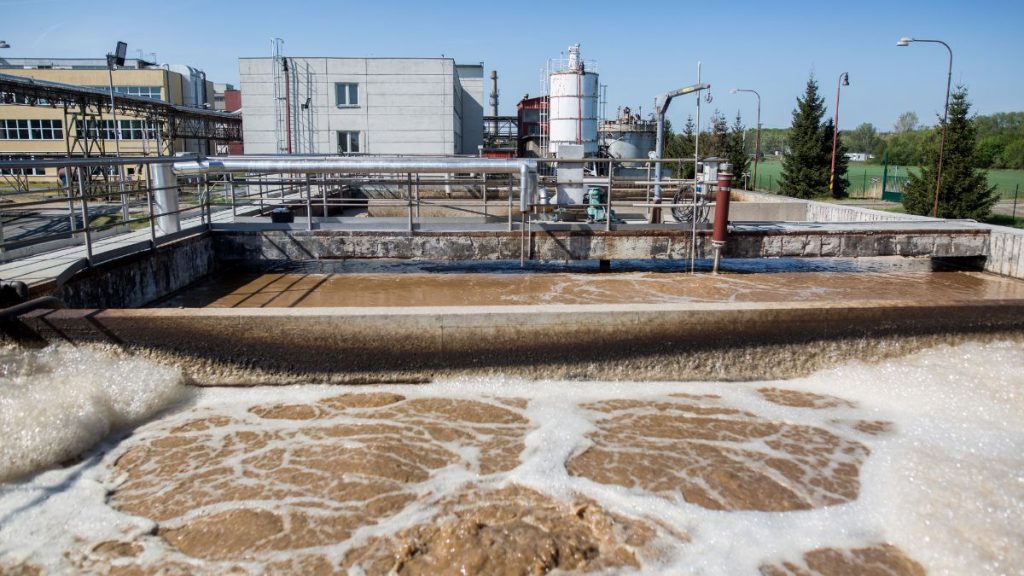Maintaining proper dissolved oxygen in wastewater is one of the most critical factors in ensuring efficient and effective wastewater treatment. Dissolved oxygen (DO) directly influences biological activity, pollutant removal efficiency, and the overall stability of the treatment process.
Without sufficient DO, wastewater treatment plants can experience operational issues such as unpleasant odors, reduced treatment performance, and even system failure. Understanding what dissolved oxygen is and how it functions within various stages of wastewater treatment is essential for maintaining optimal plant performance and environmental compliance.
What Is Dissolved Oxygen in Water?
Dissolved oxygen (DO) refers to the amount of free, non-compound oxygen present in water. It is typically measured in milligrams per liter (mg/L) and represents the oxygen available for aquatic organisms and microbial activity. In natural water bodies, oxygen enters the water through atmospheric diffusion, photosynthesis by aquatic plants, and water turbulence. However, in engineered systems like wastewater treatment plants, dissolved oxygen levels are carefully controlled to support biological treatment processes.
In wastewater treatment, microorganisms rely on dissolved oxygen to break down organic matter and convert pollutants into simpler, less harmful compounds. These biological processes, primarily aerobic, depend heavily on the presence of adequate oxygen levels. The concentration of DO serves as an indicator of how well these biological systems are performing and whether the treatment process is balanced.
Read Also: Oxygen Scavengers: Functions, Types, and Applications in Water Treatment
The Importance of Dissolved Oxygen in Wastewater Treatment
Dissolved oxygen plays a vital role in determining the efficiency and effectiveness of biological wastewater treatment. It supports the survival and activity of aerobic bacteria, which are responsible for degrading organic pollutants. Insufficient DO levels can lead to incomplete treatment, foul odors, and the formation of undesirable by-products like hydrogen sulfide or methane.
1. Supporting Aerobic Microorganisms
Aerobic microorganisms require oxygen to oxidize organic compounds, converting them into carbon dioxide, water, and biomass. When DO levels fall below optimal ranges (typically 2–4 mg/L for most biological treatment systems), the microbial population shifts towards anaerobic species. This change not only reduces treatment efficiency but also produces unpleasant odors and potential toxicity issues.
2. Preventing Septic Conditions
Low DO concentrations can cause wastewater to become septic, leading to the production of hydrogen sulfide and ammonia gases. These compounds create strong odors and can corrode equipment and infrastructure within the treatment plant. Maintaining adequate dissolved oxygen prevents these anaerobic conditions and ensures a stable, odor-free operation.
3. Enhancing Process Stability
Fluctuations in DO levels can destabilize biological processes. Consistent oxygen availability helps maintain a balanced microbial community and supports steady pollutant removal. Proper DO management allows operators to control the biological oxygen demand (BOD) more effectively, ensuring compliance with discharge regulations.
4. Optimizing Energy Use
While aeration is one of the most energy-intensive operations in wastewater treatment, maintaining the correct DO level ensures that energy is used efficiently. Over-aeration wastes electricity, while under-aeration reduces treatment performance. Therefore, precise monitoring and control of dissolved oxygen are essential for balancing energy efficiency with treatment effectiveness.
The Role of Dissolved Oxygen in Different Stages of Wastewater Treatment
The significance of dissolved oxygen varies throughout the stages of wastewater treatment. From preliminary treatment to final discharge, DO levels must be carefully managed to support each process’s specific objectives.
1. Primary Treatment
In the primary stage, wastewater undergoes physical separation to remove large solids and debris. Although aeration is minimal at this point, maintaining a certain level of dissolved oxygen helps reduce odor formation and prevents the development of anaerobic zones in sedimentation tanks. This step sets the foundation for stable downstream biological processes.
2. Secondary (Biological) Treatment
This stage is where dissolved oxygen plays its most critical role. The secondary treatment relies heavily on biological processes such as the activated sludge system, trickling filters, or oxidation ditches. Here, microorganisms decompose organic pollutants, and the rate of this degradation depends directly on the amount of oxygen available.
- Activated Sludge Process: Aeration tanks supply oxygen to maintain DO levels between 2–4 mg/L, supporting aerobic microbial activity. Too little oxygen can cause sludge bulking, while too much leads to energy wastage.
- Trickling Filters: DO diffuses naturally through air contact, and maintaining airflow is key to sustaining microbial growth on filter media.
- Oxidation Ditches: These systems use mechanical aerators to maintain a continuous supply of oxygen, ensuring the biological process remains stable and effective.
Proper DO control during secondary treatment ensures efficient reduction of BOD and COD, resulting in cleaner effluent ready for further polishing.
Read Also: COD and BOD in Palm Oil Mill Effluent: Challenges and Solutions
3. Tertiary Treatment
In tertiary treatment, DO continues to play an essential role in advanced purification and nutrient removal. Processes such as nitrification and denitrification rely on alternating aerobic and anoxic conditions.
During nitrification, aerobic bacteria convert ammonia into nitrate using oxygen, while in denitrification, anoxic conditions convert nitrate into nitrogen gas. Maintaining precise DO levels allows these reactions to occur effectively, ensuring nitrogen removal and compliance with discharge standards.
4. Final Discharge and Receiving Waters
Even after treatment, maintaining adequate dissolved oxygen in effluent is important before discharge into natural water bodies. Low-oxygen effluent can harm aquatic ecosystems by depleting oxygen levels in rivers or lakes, leading to fish kills and other ecological imbalances.
Continuous DO monitoring ensures that treated water meets environmental regulations and supports healthy aquatic life.
Conclusion
Managing dissolved oxygen in wastewater is not just a technical necessity. It’s a crucial factor in achieving efficient treatment, operational stability, and environmental compliance. From ensuring proper microbial activity to optimizing energy use, DO management lies at the heart of successful wastewater operations.
With over 40 years of expertise, Lautan Air Indonesia provides comprehensive wastewater treatment solutions, including operation & maintenance, chemical dosing, and monitoring instrumentation designed to help industries maintain optimal dissolved oxygen levels and achieve superior treatment performance.
Whether your facility faces challenges with biological treatment efficiency, odor control, or energy optimization, Lautan Air Indonesia can deliver tailored solutions to meet your operational and regulatory needs.
Ensure your wastewater treatment system operates at its best — partner with Lautan Air Indonesia today for reliable, efficient, and sustainable water management.



